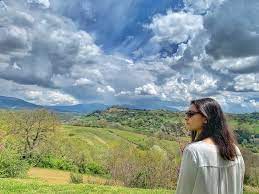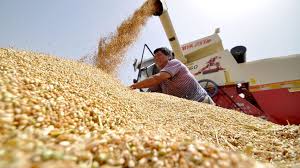Italy: Exploring the villages of the Sabina Region north of Rome

Rome: Where is Sabina and what is it best known for? For many people who live in Rome it is an area they have heard of but never visited. It starts about 30 km north-east of the city and runs on up the eastern bank of the Tiber for about another 50 km, while extending eastwards from the riverbank into the Apennines of central Italy.
It is little known because the ancient salt road, the Via Salaria, although it enters the Sabina, turns away northeast at Passo Corese, heading towards Rieti. It then runs on to the Adriatic, skirting the Sabine mountains and missing the virtually unchanged mediaeval hilltop villages of the area.
However, the reason why most Romans know its name is its prestigious olive oil and also because of the legend of the Rape of the Sabine women so vividly expressed in Poussin’s 17th-century painting, today hanging in the Louvre.
The Sabine mountains, rising to 1,282 metres at Monte Tancia, divide the undulating olive groves of lower Sabina from the higher level Rieti plain and the lakes and river valleys of upper Sabina.

Long ago, these upland streams deposited so much limestone that they became blocked and created lakes and a swamp north of Rieti. In 271 BC, the Romans drained the area by cutting a channel to the edge of the escarpment above Terni. Today the spectacular Marmore waterfall is recognised as the highest man-made waterfall in Europe.
It drains the Velino River from the Rieti plain, which is also known as the Holy Valley because it contains four Franciscan monasteries. Check the website to find out when the spectacular openings of the waterfall take place.
St Francis came from Assisi, but he visited and lived for many years near the mediaeval village of Greccio, high above the Rieti plain. Shortly after his death, his followers built a monastery on the cliffs where he slept and where, in 1223, he organised the first ever living nativity play, re-enacting the birth of Jesus at Bethlehem (now twinned with Greccio).

Every year during the Christmas period, the play is re-enacted on various evenings by monks and villagers using real cattle and a donkey. The monastery itself has a collection of model nativity scenes, ranging from an igloo to a tent in the Sahara.
Lower Sabina boasts an important abbey at Farfa, which is well worth a visit. It dates back to the fifth century and was one of the most important abbeys in Europe in its day. Damaged by fire during the Saracen invasions of the mid-ninth century, it was soon rebuilt.
Because of the threat of Saracen invasions, Pope John III issued a papal bull in 966, ordering the fortification of all the property occupied by the nobility in Sabina. This period of castellamento saw walls, gateways, defensive towers and castles built all over Sabina.
This, then, is what we see today: mediaeval hilltop villages dominated by castles and encircled by tall walls and defensive towers dating back to the late 10th and early 11th century, often perched on rocky outcrops or hilltops. All these villages have picturesque festivals throughout the year, advertised on their pro loco websites.

Roccantica clings to the flank of the Sabine mountains, a dozen kilometres north of the town of Poggio Mirteto. Dominated by its castle, which became a monastery in the 13th century, the village looks out over olive groves and away to the Tiber, with the rugged outline of Monte Soratte on the horizon.
Events worth attending start on the Sunday following the 17 January celebration of St Anthony, on whose feast day by tradition animals are blessed. The piazza is filled with the horses and mules that carry logs down from the mountains above, a flock of sheep, an occasional bull, horses, dogs, cats and caged birds. The event is combined with the Feast of the Poor, so wine and sweets are handed out to one and all while the priest blesses the animals.
February sees a religious procession honouring St Valentine, while in mid March, on the Sunday after the feast of St Joseph the air is filled with a strange smell at the Sagra del Frittello as long queues form to buy packets of fried cauliflower.
Revellers dance in the square and village troubadours in mediaeval costume put on a flag-waving display.In mid August, a four-day mediaeval feast takes place, and the small squares come alive with villagers in costume, food served at tables, dancing, troubadour performances, plays and a nighttime re-enactment of the famous 1059 assault on the tower where the future pope, Nicolas II, was said to have been besieged.
The village was attacked by troops sent by the Roman nobility, and in particular the Crescenzi family, who wanted Giovanni the bishop of Velletri as pope. In September another religious procession is held in honour of the Madonna.
Roccantica is a perfect place from which to set off on a walk, while riding lessons and pony trekking are available nearby. Le Cucine del Borgo restaurant offers an inviting menu while the Del Compare trattoria provides Sardinian specialities. La Tana del Branco bar has a panoramic terrace where they can serve food if told in advance.
A little to the south, above Poggio Catino on the winding mountain road to the Rieti plain, lies the Tancia Hostel House. Once a hostel for shepherds during the transhumance, it has been taken over by a group of enthusiastic young locals who organise trekking, bike tours, horse riding and much more.

During the year, Poggio Mirteto has two carnivals in April, one of which is called the “Liberata”, contentiously celebrating the fall of the Papal States in 1861. In May, Selci offers an evening of “Wine under the Stars”, while Configni – located just off the SP313 road from Passo Corese to Terni near the northern Lazio border – holds a wild mushroom and asparagus festival.
Bocchignano, situated between Poggio Mirteto and Farfa Abbey, holds a jazz festival at the end of May or early June, while live music and al fresco food is also available at Halloween in neighbouring Poggio Catino, where legend has it that witches have been known to appear and dance in the square.
Activities in Sabina include skiing in the winter at Monte Terminillo, about 21 kms from Rieti. Hikers can also follow the many marked footpaths accessible from the villages lying on both sides of the Sabine mountains.
Other fascinating sites to visit are the two hermitages behind Roccantica and those at Cottanello and Vacone, while everyone with a taste for “the nectar of the gods” can visit the producers of the famous olive oil under the guidance of an international olive oil judge.
For those who prefer two wheels, bicycles can be hired in Poggio Mirteto, from where you can follow the level contours of the SP48 northwards passing below Poggio Catino and Roccantica to Casperia and beyond.
Swimming is available at the riverside pools below the abbey at Farfa or at the Almalama pool near Casperia, where you can also play tennis. Canoes are available for hire in the Tevere-Farfa nature reserve, where walkers often see foxes, wild boar and many species of bird.
The reserve’s visitor centre is on the western bank of the Tevere and is approached from Nazzano. Riding lessons and pony trekking are also available outside Roccantica and Casperia.
Sunday markets take place at Osteria Nuova and Farfa on the first Sunday of the month, at Gavignano the third and Borgo Nuovo on the fourth. A small arts and crafts market takes place at Casperia every second Sunday of the month.
As of this autumn, the trains to Poggio Mirteto station from Fiumicino airport via Rome are scheduled to increase their frequency to every 15 minutes. They are met by Troiani buses going up to Poggio Mirteto (on market-day Fridays) and Cotral to the various surrounding villages.
Sabina remains a beautiful and interesting destination today just as it did when the Romans invaded and carried off the local beauties all those centuries ago.





